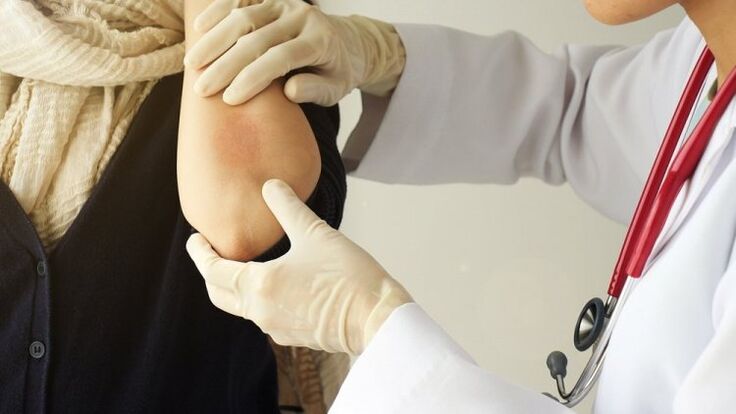Psoriasis is one of the most common chronic dermatoses. During such a pathological process, damage to the skin, as well as skin appendages, are detected. The urgency of this problem lies in the fact that it leads to a deterioration in the quality of life of a sick person due to aesthetic disturbances.
Most often, the first episode of psoriasis occurs between the ages of fifteen and forty-five. According to statistics, this disease is diagnosed in about three percent of the total population. In addition, the number of women and men with such a pathology is in equal parts.
There are several theories about how psoriasis develops. The main one is the autoimmune theory, which says that this pathological process arises as a result of an incorrect immune response to external factors. An excessive immune response leads to the development of an inflammatory reaction in the layers of the skin, which triggers the mechanisms of division and multiplication of cell structures. In addition, it is believed that hereditary predisposition and exposure to various infectious agents can play a role in the development of this disease.
It is found that psoriasis is most common in people who:
- have other dermatological diseases;
- Have thin and dry skin;
- Smoking and drinking alcohol;
- Systematically come into contact with irritating chemicals;
- They often injure the skin through mechanical influences;
- Pay attention to excessive hygiene;
- Are exposed to heavy loads;
- Have a decreased immune response or are taking medication that suppresses immunity.
Depending on the symptoms of psoriasis, it is customary to divide this pathology into several forms:
- Badge shape. This form is the classic version. It occurs in more than eighty percent of people. In this case, the clinical picture is characterized by typical scaly plaques that tend to grow peripherally;
- Teardrop shape. The disease proceeding in this form is accompanied by the appearance of numerous small foci on the surface of the skin. Such lesions can be a completely different color, protrude above the surface of the skin and peel off intensely. As a rule, they do not get any bigger, only their number increases;
- Exudative form. It's one of the worst options. In this case, bubbles and blisters filled with serous fluid form on the surface of the plaques. Very often such elements undergo secondary infection, with the subsequent appearance of pus;
- Psoriatic onychodystrophy. It is characterized by the involvement of the nail plates in the pathological process, which are striped and thickened. In most cases, the nails will discolor, peel, and break off. In advanced cases, complete loss of the nail plate is possible;
- Psoriatic arthropathy. The symptoms of psoriasis are expressed in this case by inflammation of the joints and connective tissue. In some cases, this form develops on its own, but most often it is accompanied by skin manifestations;
- Psoriatic erythroderma. This form is characterized by a very severe course and is often fatal. The development of inflammation in large areas of the body, accompanied by intense peeling and peeling of the skin, is noted.
The main symptoms of psoriasis

We will talk in more detail about the classic shape. What does psoriasis look like? First, individual papules that are pink or red in color appear on the surface of the skin. These papules are covered with silvery-white scales that are easy to scrape off. Over time, the number of papules increases more and more, they begin to merge into plaques.
The plaques formed during this disease have a hyperemic and edematous appearance. In some cases, the skin may be slightly itchy. Pathological foci tend to grow more rapidly on the periphery, and their surface is very scaly. Over time, plaques stop growing and their boundaries become clear. A specific sign of such a pathological process is a pseudoatrophic border, which is localized along the periphery of the foci. In the steady state, the appearance of a stagnant cyanotic hue is noted on the surface of the plaques.
Symptoms of psoriasis at the stage of regression are characterized by the gradual disappearance of desquamation, starting from the central part. After that, the skin takes on a normal color, after which the tissue infiltration disappears.
Diagnosis and treatment of this disease

First of all, psoriasis is determined based on its clinical picture. There is a triad of specific phenomena that indicate this pathological process: stearin stain, terminal film, and blood thaw. The phenomenon of a stearin stain is that as the lesion is scraped off, the peeling becomes more intense. If we continue to scratch, peeling of the thin film and the appearance of a wet and hyperemic surface are noted - the phenomenon of a final film. The phenomenon of blood thaw implies the presence of a punctiform hemorrhage with further scratching.
Of the drugs for this disease, the following can be used:
- Glucocorticosteroids;
- Cytostatics;
- Antihistamines;
- Keratolytic and anti-inflammatory ointments.
In addition, various physiotherapy treatments are widely used.
Prevention of exacerbations in psoriasis
To prevent exacerbations, it is recommended to avoid stressful situations, give up bad habits and eat well. In addition, you should limit irritation to the skin and avoid contact with substances to which you are allergic.

























